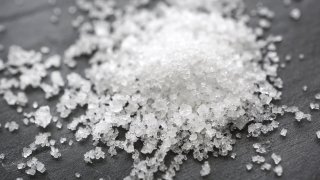
The global market for salt was worth over an estimated $13 billion in 2021, according to Research Insights.
This valuation comes after a rich global history showcasing wars fought over salt, trade routes built for commodities, taxes levied against the mineral and even cities named in sodium's legacy.
Salt has shaped the global economy — and the way we use it has shifted dramatically throughout history.
"You could not have an international economy if you didn't have salt," Mark Kurlansky, author of "Salt: A World History," told CNBC. "There was very little food you could export without salt. Vegetables, meat, fish, dairy products."
We're making it easier for you to find stories that matter with our new newsletter — The 4Front. Sign up here and get news that is important for you to your inbox.
Today, the common uses of salt are just as prolific but less apparent.
Road salt
Highway deicing salts accounted for about 42% of total salt consumed in 2022, according to the U.S. Geological Survey.
Money Report
But now, since the rise of refrigeration and frozen food, salt is primarily used on snowy and icy roads and highways to make them drivable.
"We're seeing that the majority is deicing salt," Seth Goldstein, equities analyst with Morningstar, told CNBC.
The University of Vermont estimated that the U.S. uses 20 million metric tons of salt on roads every year.
However, if too much salt permeates our environment, the effects can be dangerous, according to the Environmental Protection Agency.
Runoff from deicing salts that keep our roads safe in wintry weather is the most obvious way that salt enters the environment. It is estimated to cause anywhere from $800 to $3,300 in structural damage for every ton used, according to the EPA.
"This is an issue that affects everybody on a daily basis," Sujay Kaushal, scientist and professor with the University of Maryland, told CNBC.
Kaushal has studied freshwater salinization syndrome and its impact on drinking water, ecosystems and infrastructure corrosion.
"We found that some of the major rivers and streams in the world have been showing these increasing trends," Kaushal said.
Lower chloride products
Salt is corrosive because chlorides corrode metal. But sodium chloride isn't the only form of salt. Mineral salts are abundant.
"Parking lots, pavements, buildings and all that," Kaushal said of cement structures made of calcium carbonate, which are a type of mineral salt. "When they break down, they release salts into the environment."
Those salts reach freshwater sources as water moves through the ground. This can create what the EPA calls "salt chemical cocktails" that can pollute drinking water sources and damage infrastructure.
Then, metal pipes with saltier water flowing through may experience metal leaching from their walls, adding more contaminants to the water.
Some cities are taking note of the issue and are opting for lower chloride products, which have entered the market, as a solution.
"We've seen significant increases in the amount of ice melter that we have sold with lower fewer chlorides in it versus straight rock salt, which has a significant amount of chlorides in it," Bryon Maze, sales and marketing manager at salt distributor Harvey Salt Company, told CNBC.
Watch the video above to learn more about how salt became one of the most game-changing minerals in the world, where salt is sourced, what can happen when water keeps getting saltier and possible solutions for a saltier world.






